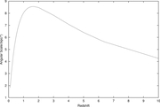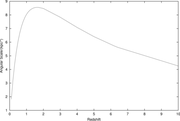
Angular diameter distance
Encyclopedia
The angular diameter distance is a distance measure used in astronomy
. The angular diameter distance to an object is defined in terms of the object's actual size, , and
, and  the angular size of the object as viewed from earth.
the angular size of the object as viewed from earth.

The angular diameter distance depends on the assumed cosmology
of the universe. The angular diameter distance to an object at redshift
, , is expressed in terms of the comoving distance
, is expressed in terms of the comoving distance
, as:
as:

Where is defined as:
is defined as:

Where is the curvature density and
is the curvature density and  is the value of the Hubble parameter today.
is the value of the Hubble parameter today.
In the currently favoured geometric model of our Universe
, the "angular diameter distance" of an object is a good approximation to the "real distance", i.e. the proper distance
when the light left the object. Note that beyond a certain redshift
, the angular diameter distance gets smaller with increasing redshift
. In other words an object "behind" another of the same size, beyond a certain redshift (roughly z=1.5), appears larger on the sky, and would therefore have a smaller "angular diameter distance".

 The angular size redshift relation describes the relation between the angular size observed on the sky of an object of given physical size, and the objects redshift
The angular size redshift relation describes the relation between the angular size observed on the sky of an object of given physical size, and the objects redshift
from Earth
(which is related to its distance, , from Earth). In a Euclidean
, from Earth). In a Euclidean
geometry the relation between size on the sky and distance from Earth would simply be given by the equation:

where is the angular size of the object on the sky,
is the angular size of the object on the sky,  is the size of the object and
is the size of the object and  is the distance to the object. Where
is the distance to the object. Where  is small this approximates to:
is small this approximates to:
 .
.
However, in the currently favoured geometric model of our Universe
, the relation is more complicated. In this model, objects at redshift
s greater than about 1.5 appear larger on the sky with increasing redshift
.
This is related to the angular diameter distance, which is the distance an object is calculated to be at from and
and  , assuming the Universe is Euclidean
, assuming the Universe is Euclidean
.
The actual relation between the angular-diameter distance, , and redshift is given below.
, and redshift is given below.  is called the deceleration parameter and measures the deceleration of the expansion rate of the Universe; in the simplest models,
is called the deceleration parameter and measures the deceleration of the expansion rate of the Universe; in the simplest models,  corresponds to the case where the Universe will expand for ever,
corresponds to the case where the Universe will expand for ever,  to closed models which will ultimately stop expanding and contract
to closed models which will ultimately stop expanding and contract  corresponds to the critical case – Universes which will just be able to expand to infinity without re-contracting.
corresponds to the critical case – Universes which will just be able to expand to infinity without re-contracting.

The Mattig relation yields the angular-diameter distance as a function of redshift for a universe with ΩΛ = 0.
Astronomy
Astronomy is a natural science that deals with the study of celestial objects and phenomena that originate outside the atmosphere of Earth...
. The angular diameter distance to an object is defined in terms of the object's actual size,
 , and
, and  the angular size of the object as viewed from earth.
the angular size of the object as viewed from earth. 
The angular diameter distance depends on the assumed cosmology
Physical cosmology
Physical cosmology, as a branch of astronomy, is the study of the largest-scale structures and dynamics of the universe and is concerned with fundamental questions about its formation and evolution. For most of human history, it was a branch of metaphysics and religion...
of the universe. The angular diameter distance to an object at redshift
Redshift
In physics , redshift happens when light seen coming from an object is proportionally increased in wavelength, or shifted to the red end of the spectrum...
,
 , is expressed in terms of the comoving distance
, is expressed in terms of the comoving distanceComoving distance
In standard cosmology, comoving distance and proper distance are two closely related distance measures used by cosmologists to define distances between objects...
,
 as:
as:
Where
 is defined as:
is defined as:
Where
 is the curvature density and
is the curvature density and  is the value of the Hubble parameter today.
is the value of the Hubble parameter today.In the currently favoured geometric model of our Universe
Lambda-CDM model
ΛCDM or Lambda-CDM is an abbreviation for Lambda-Cold Dark Matter, which is also known as the cold dark matter model with dark energy...
, the "angular diameter distance" of an object is a good approximation to the "real distance", i.e. the proper distance
Comoving distance
In standard cosmology, comoving distance and proper distance are two closely related distance measures used by cosmologists to define distances between objects...
when the light left the object. Note that beyond a certain redshift
Redshift
In physics , redshift happens when light seen coming from an object is proportionally increased in wavelength, or shifted to the red end of the spectrum...
, the angular diameter distance gets smaller with increasing redshift
Redshift
In physics , redshift happens when light seen coming from an object is proportionally increased in wavelength, or shifted to the red end of the spectrum...
. In other words an object "behind" another of the same size, beyond a certain redshift (roughly z=1.5), appears larger on the sky, and would therefore have a smaller "angular diameter distance".
Angular size redshift relation


Redshift
In physics , redshift happens when light seen coming from an object is proportionally increased in wavelength, or shifted to the red end of the spectrum...
from Earth
Earth
Earth is the third planet from the Sun, and the densest and fifth-largest of the eight planets in the Solar System. It is also the largest of the Solar System's four terrestrial planets...
(which is related to its distance,
 , from Earth). In a Euclidean
, from Earth). In a EuclideanEuclidean
Euclidean relates to Euclid , a town or others. It may refer to:Geometry...
geometry the relation between size on the sky and distance from Earth would simply be given by the equation:

where
 is the angular size of the object on the sky,
is the angular size of the object on the sky,  is the size of the object and
is the size of the object and  is the distance to the object. Where
is the distance to the object. Where  is small this approximates to:
is small this approximates to: .
.However, in the currently favoured geometric model of our Universe
Lambda-CDM model
ΛCDM or Lambda-CDM is an abbreviation for Lambda-Cold Dark Matter, which is also known as the cold dark matter model with dark energy...
, the relation is more complicated. In this model, objects at redshift
Redshift
In physics , redshift happens when light seen coming from an object is proportionally increased in wavelength, or shifted to the red end of the spectrum...
s greater than about 1.5 appear larger on the sky with increasing redshift
Redshift
In physics , redshift happens when light seen coming from an object is proportionally increased in wavelength, or shifted to the red end of the spectrum...
.
This is related to the angular diameter distance, which is the distance an object is calculated to be at from
 and
and  , assuming the Universe is Euclidean
, assuming the Universe is EuclideanEuclidean
Euclidean relates to Euclid , a town or others. It may refer to:Geometry...
.
The actual relation between the angular-diameter distance,
 , and redshift is given below.
, and redshift is given below.  is called the deceleration parameter and measures the deceleration of the expansion rate of the Universe; in the simplest models,
is called the deceleration parameter and measures the deceleration of the expansion rate of the Universe; in the simplest models,  corresponds to the case where the Universe will expand for ever,
corresponds to the case where the Universe will expand for ever,  to closed models which will ultimately stop expanding and contract
to closed models which will ultimately stop expanding and contract  corresponds to the critical case – Universes which will just be able to expand to infinity without re-contracting.
corresponds to the critical case – Universes which will just be able to expand to infinity without re-contracting.
The Mattig relation yields the angular-diameter distance as a function of redshift for a universe with ΩΛ = 0.

